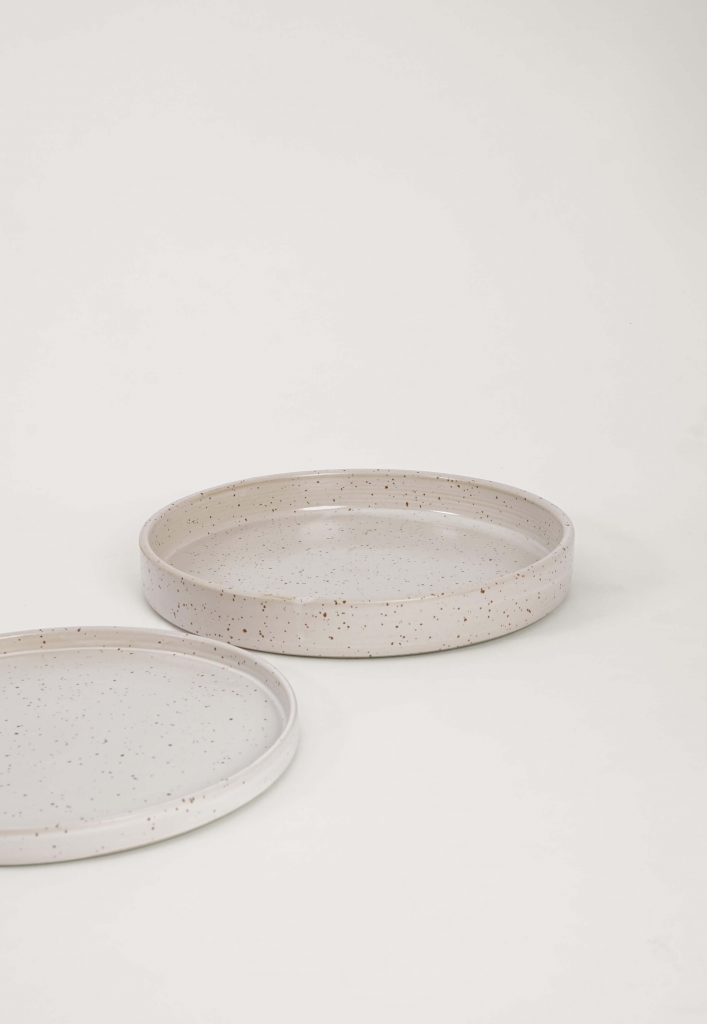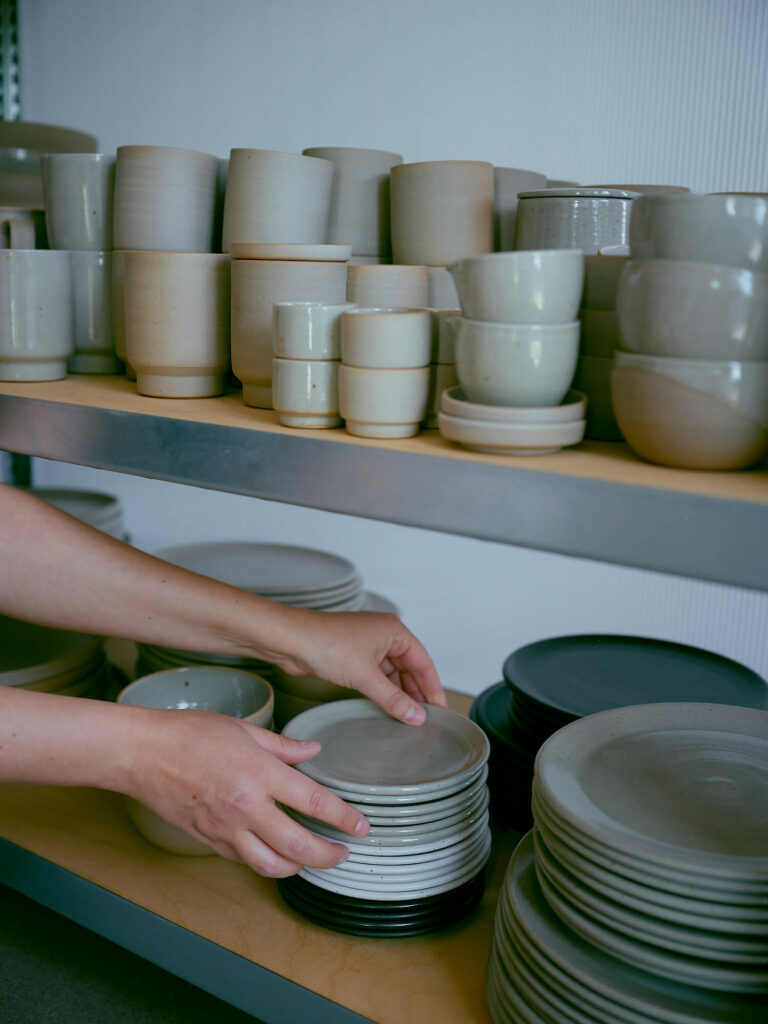Quality Stoneware Ceramics for practicing and exploring Ikebana, Moribana, and Nageirebana
The Art of Ikebana: Experience New Balance between Man, Nature and Matter
In today’s hectic world, where time is a precious resource and technology dominates our daily lives, many long for moments of calm and balance. Ikebana, Moribana, and Nageirebana are art forms that can satisfy this longing and are deeply rooted in Japanese culture and spirituality.
In this article, I delve into the richness of Eastern mentality and its potential impact on Western practices. Discover how these traditional Japanese art forms can offer valuable insights into prioritising quality over quantity, fostering a more conscious way of life.
Join me as we explore these time-honored techniques and glean inspiration for a future-forward approach.


The Essence of Ikebana
Ikebana is much more than just arranging flowers in ikebana ceramics. It is an artistic form of expression that celebrates the interaction between man, nature and the material world. This art form, which has its origins in Japanese culture, goes beyond mere aesthetics and embodies deep philosophical principles, particularly from Zen Buddhism.

Interaction with nature by bringing it into your work and living space
In the practice of ikebana, each individual component of the arrangement is carefully selected and placed, taking into account both external beauty and internal meaning. The deliberate inclusion of not only flowers, but also branches, leaves and stones creates a harmonious relationship between the elements and their surroundings.
“The ikebana arrangement should on the one hand bring nature into the living space of man, but at the same time represent the cosmic order. Through the arrangement, the creator represents both his relationship to nature and the feelings that move him during the creation process. In the classical schools of ikebana, the respective season must always be recognisable through the choice of material. In contrast to the decorative form of flower arrangement in the western world, ikebana creates a harmony of linear structure, rhythm and colour. While in the West the number and colour of the flowers are emphasised and attention is mainly paid to the blossoms, the Japanese emphasise the linear aspects of the arrangement. In this art, the vase, stems, leaves, branches and flowers are also emphasised. Most Ikebana forms are based on the three lines shin (真), soe (副) and tai (体), which symbolise heaven, humanity and earth.”
(source)


This interaction reflects the close connection between man and nature and reminds us that we are an integral part of the larger ecosystem. The handmade stoneware ceramics not only build on the centuries-old tradition of human interaction with the natural raw material of clay, but also represent an investment in an aesthetic that values patience and celebrates both humanity and nature in the objects.
The art practice of ikebana, as well as the artisanal use of natural raw materials such as clay, wood, stone, metal, pigments and more, including the use of real stoneware ceramics, embodies the idea of a deep connection between humanity and nature. This connection stands in contrast to dependence on machines, technology or large corporations and leads to an appreciation for the living.

Differences Between Ikebana, Moribana, and Nageirebana
Ikebana, Moribana, and Nageirebana represent three distinct styles of Japanese floral arrangement, each with its own unique characteristics. Ikebana, often referred to as the art of Japanese flower arranging, emphasizes simplicity, asymmetry, and the use of negative space to create a harmonious balance between flowers, stems, and branches.
Moribana (meaning »Full Bloom Flowers«), on the other hand, is known for its structured and compact arrangement, typically utilizing a shallow container, also known as a suiban, and floral frogs (»Kenzan«) to hold the flowers in place.


by REH (GERMANY) handmade in Germany
Nageirebana (meaning “Thrown in”), meanwhile, is characterised by its freeform, naturalistic style, where flowers are casually arranged in a tall vase. Understanding the differences between these three styles allows enthusiasts to appreciate the diverse beauty and techniques of Japanese floral artistry..
Seika Ikebana, rooted in the structural rules and classical aesthetics of the ancient rikka style from the Ikenobō school, emphasizes the concept of shusshō (Inner Beauty). This Ikebana principle focuses on showcasing the living forms of plants, rooted in the soil and growing upward towards the sun. Seika arrangements typically use one to three kinds of floral materials, beautifully arranged in a single vase.
Integrating Ikebana in Western Flower Arrangements
We learned that, in contrast to the decorative flower arrangements common in the Western world, Eastern flower arrangement philosophies, particularly in Ikebana, emphasise the quality of minimalism and the inherent value of nature. The art of Ikebana centers on a few carefully chosen elements for greater depth, such as single flowers or branches, rather than the quantity of flowers or the size of the flower bouquet, as is common in Western arrangements.


For the Ikebana ceramic photo shoot with photographer Sonja Stadelmaier, we selected tree blossoms, wild flowers, plant leaves and stones for the Moribana arrangements in the flat suiban plate bowls by REH (GERMANY).
A floral frog, known as a »Kenzan«, is used for the Japanese art of flower arranging, especially for Moribana. The »Kenzan« is placed in a waterproof and flat ceramic suiban vessel filled with water, such as the semi-glazed »Beuys« tray plates from REH (GERMANY).
These large Ikebana ceramics measure a diameter of 30cm and are available in timeless grey, semi-glazed, speckled white and matt black. Each traditional stoneware ceramic by REH (GERMANY) is unique, because it is carefully crafted and glazed by hand to a high standard in Germany, today. Thanks to the high firing temperature of 1300 °C, the ceramics are waterproof and dishwasher-safe.


The roots in Japanese Zen or Buddhism
The roots of ikebana go back deep into Japanese Zen philosophy and Buddhism. Zen teaches the art of mindfulness and consciously being in the present moment. Ikebana reflects these principles by focussing attention on the beauty and transience of the moment. By arranging flowers in a calm and meditative atmosphere, practitioners can create a deep spiritual connection to nature while finding inner peace.
The importance of ikebana in the modern world
In a world characterised by speed and superficiality, ikebana offers a counterbalance. It invites us to pause and recognise the beauty in simplicity. Through the practice of ikebana, we can not only develop our artistic sensibility, but also gain a deeper appreciation for nature and its subtle beauty.
Observing how the material world around us is created and our interaction with it is an essential experiential process that we must preserve.


What Can You Learn from Ikebana?
Ikebana is more than just an art form – it is a philosophy of life that can be practiced by everyone in everyday life. In a world characterised by hectic and stress, Ikebana offers us a path to inner peace and focus on less.
Internalising the merging of Eastern and Western perspectives and practices helps us achieve a more holistic view, moving beyond the prevailing dualism in the world. Exploring the space in between and the blending of cultural contrasts and nuances is a contemporary challenge worth pursuing. As it expands our horizons and allows us to recognise our similarities and interdependencies.
Learning practical techniques such as Ikebana, Moribana, or Nageirebana helps us rebalance with nature and reconnect with natural materials. These methods allow us to appreciate the beauty and transience of the moment, and the transformations we can influence.


In every culture, people experience and negotiate their similarities and differences when they come together around a table. Both ceramic collections are therefore a symbol of how important it is today to accept and integrate differences and diversity. High-quality, durable and therefore valuable everyday objects are therefore not only timeless companions, but also modern tools that can encourage us to consume less and more locally in order to have more time for the important things in life.
Explore both ceramic collections, the black and white »Polar« (2015) as well as the grey and semi-glazed »Singular« (2021) stoneware ceramic collection. Both collections are handmade by professional artisans in Germany, designed to create a meaningful connection with people and nature in everyday life.


Minimal ceramic designs for tableware and plantware by REH (GERMANY)
Photography by Berlin-based photographer Sonja Stadelmaier
Article written by Eliza Helmerich

Read more about the quality differences between stoneware ceramics and earthenware and why it’s worth investing in durable, dishwashersafe stoneware ceramic tableware…
